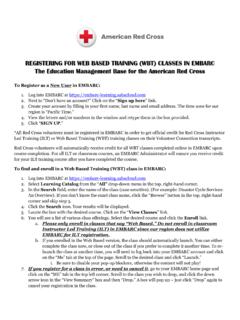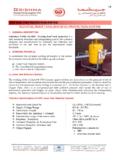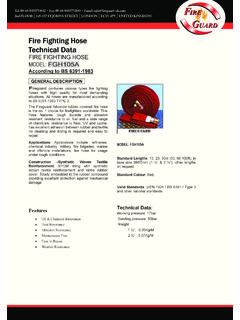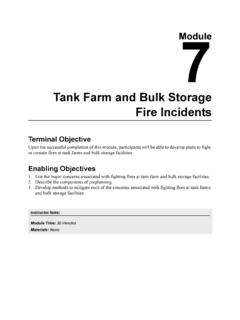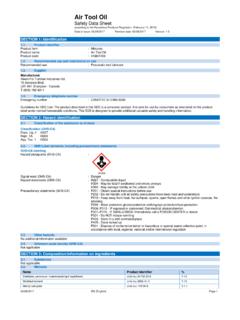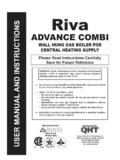Transcription of Riverside County Fire Protection Planning - …
1 Riverside County fire Protection Planning INTRODUCTION AND PURPOSE This is a guide to assist an owner/builder, general contractor or sub-contractor in the required steps of the Riverside County fire Department building and inspection process. The information provided is a general guide. As procedures can vary from one jurisdiction to another and with various types of occupancies, this guideline is to provide the basic information necessary to meet Riverside County fire Department inspection requirements. This guide also includes checklists for various types of inspections and information on how to access online County standards and pertinent codes.
2 Customer Building Matrix Guidelines fire CODES fire codes are designed to achieve a minimum level of safety, even though the level of detail in the codes is extensive they can t possibly cover every hazard or combinations of hazards. To use traffic laws as an analogy, just because you are obeying traffic laws does not mean that you will not get into an accident. The same is true of fire codes; they are designed to reduce the opportunities for fires to start, reduce the opportunities for fires to spread, provide for evacuation of occupants, and provide access for firefighters to extinguish the fire . TABLE OF CONTENTS INTRODUCTION AND PURPOSE DEFINITIONS HELPFUL TIPS REVIEW PROCESS FLOW CHART INSPECTIONS GUIDE QUESTIONS & ANSWERS REFERENCE GUIDE DEFINITIONS fire SAFETY SPECIALIST: The officer who does the building plan checks and the fire system plan checks, including verifying all calculations, materials and codes.
3 fire SYSTEMS INSPECTOR: The field inspector. PRE-POUR INSPECTION: Thrust block excavation shall be completed, but thrust blocks shall not be poured. All pipe shall be in place and exposed for visual inspection. Pipe shall be laid with ferrous pipe and fittings wrapped and tightly taped, bolts and ferrous joints coated with asphaltic sealant or other corrosion retarding material, and trench depth sufficient to allow the required cover above pipe. UNDERGROUND HYDRO TESTING: Thrust blocks or joint restraints shall be in place. Pipe shall be center-loaded to prevent up-lift, but all joints to remain exposed.
4 The system shall be hy-drostatically tested @200 psi. (or 50 psi over maximum static pressure, whichever is greater) for a duration of at least two hours prior to the arrival of the inspector. OVERHEAD (SPRINKLER) ROUGH INSPECTION AND HYDRO TESTING: Sprinkler systems requiring hydrostatic testing shall be tested a 200 psi (or 50 psi over maximum static pressure, whichever is greater) and shall maintain that pressure without loss for 2 hours. All areas of overhead piping shall be accessible for rough inspection and any equipment necessary for the inspector to make a com-plete visual inspection of the sprinkler system, the materials used and the construc-tion of the system.
5 FLUSH INSPECTION: All portions of the underground system shall be flushed to remove debris prior to connection to overhead piping. Flow shall be through a minimum of a four-inch hose or pipe. Flush and Hydro inspections may be scheduled concurrently. Upon Flush inspection, all detector check assemblies, control valves and FDC shall be clearly labeled, per code, and valves shall be locked in the open position with breakaway locks. All PIV s, FDC s and Hydrants shall be installed to required height, painted, protected and oriented per code requirements. Hydrant & FDC caps shall be in place. fire ALARM PRE-TEST: Required from the system installer indicating that the system has been thor-oughly checked before the fire department inspection.
6 Page 2 SAFETY TOPIC The difference between a small financial loss and a catastrophic loss with the potential for loss of life, will come down to the level of fire safety knowledge and the application of that knowledge in building design and operational practices. fire ALARM PRE-WIRE INSPECTION: To verify actual wiring and circuitry against the approved drawings to ensure that all are located and connected properly. Also that the approved materials have been used and installed correctly. fire ALARM ACCEPTANCE TESTING: Performed after the system has been installed to make sure it meets the de-sign criteria and functions properly.
7 All required documentation shall be present, signs posted and any specialized equipment ( : Db meter, volt meter or appliance to test heat detectors) shall be present for testing. Phone lines are required to be in-stalled. System shall be on TEST and tenants notified. CONDITIONS OF APPROVAL: Conditions assigned by fire Dept. to each set of plans. All CONDITIONS must be satisfied prior to fire Final Inspection. Copy must be provided to Inspector at Final Inspection. SHELL BUILDING FINAL INSPECTION: fire final inspection on shell building. All building fire systems must be in-spected and passed prior to shell building final.
8 All CONDITIONS issued by fire must be met. HVAC system must be operable to verify operation of duct smoke de-tectors (if required). FINAL OCCUPANCY INSPECTION: fire final inspection for occupied building or suites. All CONDITIONS issued by fire must be met prior to occupation of the building or suite. COMMODITIES: Are a combination of products, packing materials and containers. They can include; noncombustible products on pallets, ordinary combustible materials, plastics, mixed commodities, flammable and combustible liquids and aerosols, and hazardous materials. Page 3 INSPECTION SCHEDULING TIPS: YOU CAN ALWAYS CALL TO CHECK THE TIMEFRAME FOR SCHEDULING INSPECTIONS.
9 INSPECTION LINE: Riverside : 951-955-5282 Palm Desert: 760-863-8866 All construction or modification to fire Systems shall not be started until plans have been submitted and approved. Any changes made to the approved construction or materials used, in a fire System, can require plan revisions submitted or as-builts, which must be approved prior to Final Inspection, and could potentially, delay the project. Tenant improvement work should not start until the shell building, sprinkler or alarm has been finaled. Some types of inspections can be made along with other inspections; however this needs to be set up in advance so we can schedule enough time to complete all the inspections.
10 All appropriate technicians need to be present. The contractor responsible for that specific inspection should call in the request for an inspection, and be available or have an employee present. The approved plans, job card and any correction notices or pertinent paperwork should be present. The superintendant can coordinate all contractors. All permits with fire Department Conditions require a Final Inspection by the fire Department. Obtain and read your Conditions of Approval. Each condition must be satisfied prior to fire Department Final Inspection. The fire Department requires access to all gated commercial facilities and plans submitted and acceptance testing for electrically operated gates.




